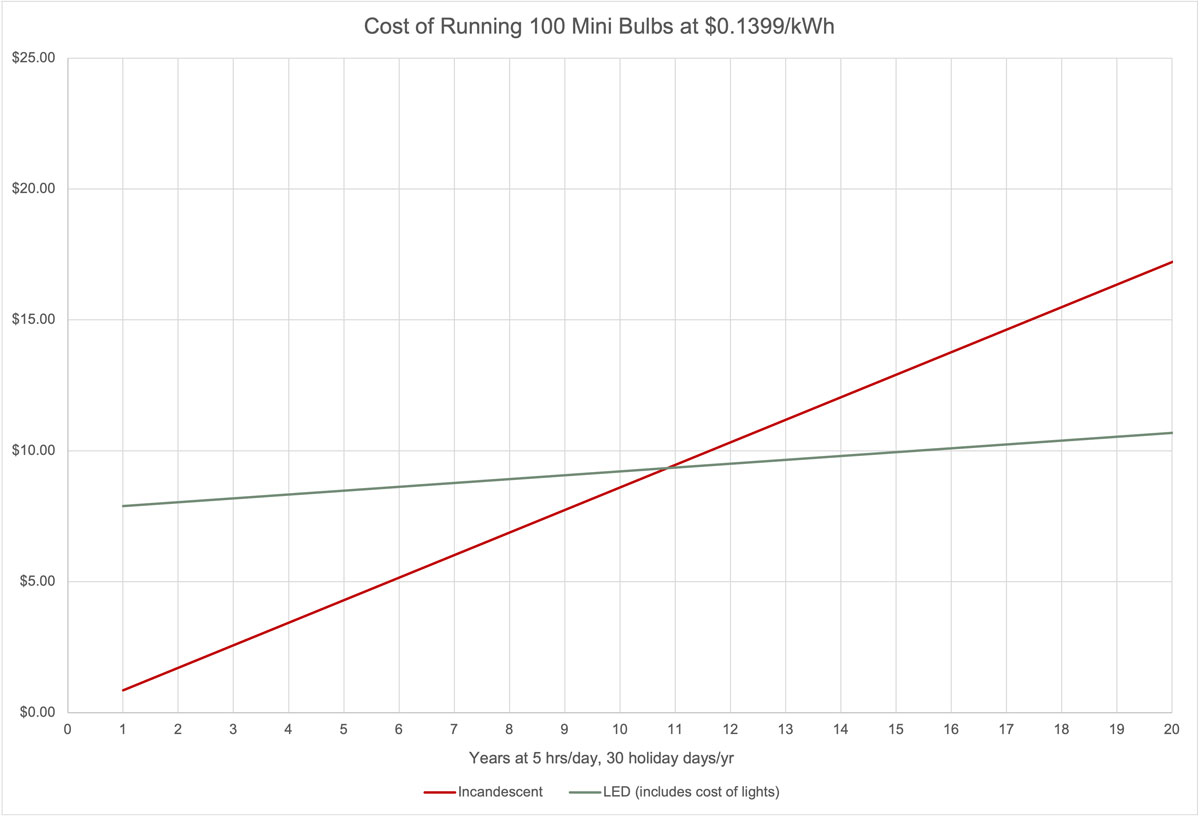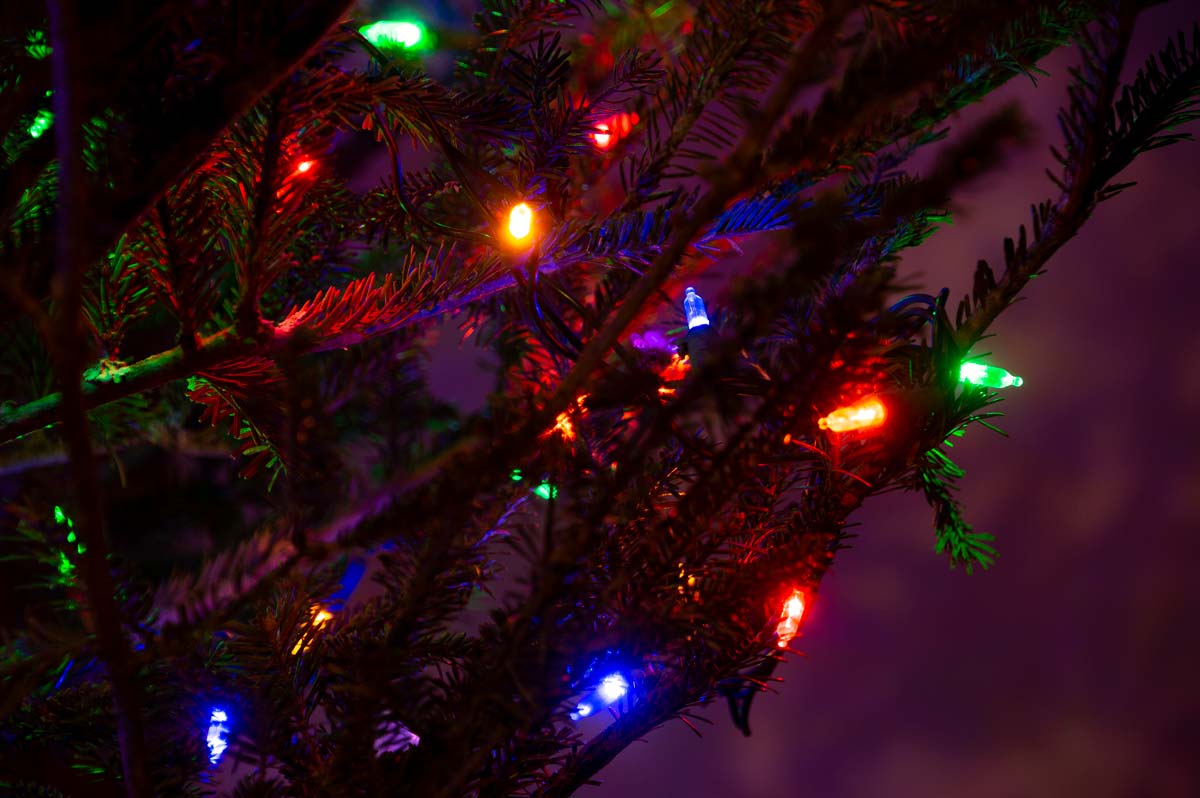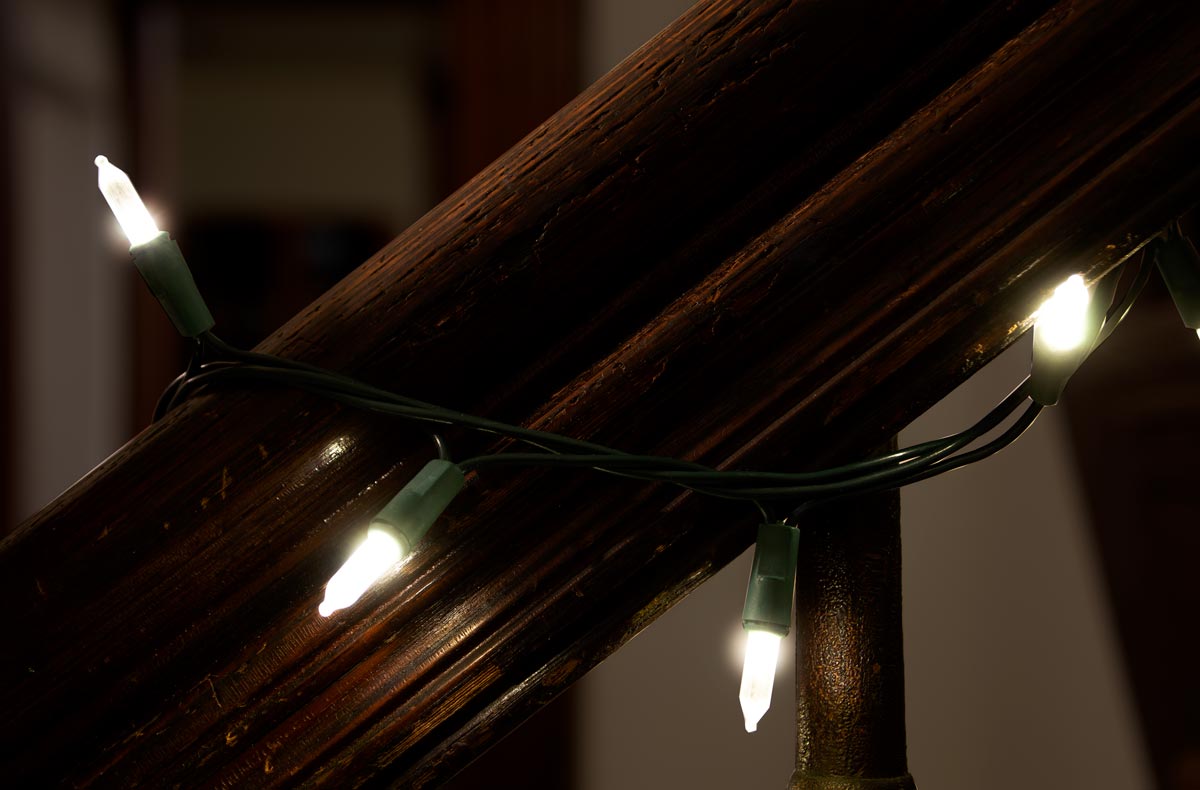Shortly after posting the last article on the money math behind switching to LED lightbulbs, I found myself decorating for the holidays and staring at another application of the technology: strings of LED Christmas lights. I have to admit, I purchased our LED Christmas lights without doing any of the math I laid out in that last post. So is it really worth it to replace your strings of traditional incandescent holiday lights with LEDs? After all, you only have them on for a short time each year.
Let’s have a look at a similar chart to the one in the last article, comparing the cost of running your existing incandescent holiday lights vs. the cost of purchasing and running new LED lights:

The green line showing the cost of LED Christmas lights starts at $7.75 because that’s about the average price of 100-light strings of mini bulbs in December 2021. The red line representing incandescent bulbs starts at $0 because we’re assuming you already own them. 100-light strings of incandescents average about 41 watts, and 100-light strings of LEDs average about 7 watts.
This graph includes a bunch of assumptions that are different from what we used for standard lightbulbs. It assumes that you’ll run your holiday lights 5 hours a day for 30 days—and then that’ll be it for the whole year. That’s why the graph shows it taking almost 11 years before the LEDs pay themselves off in energy savings over incandescents.
As with the example of normal lightbulbs, the LEDs will pay themselves back quicker relative to incandescents if your usage is higher, or of course if you can get your LED bulbs cheaper. Still, the payback period is clearly longer with less frequent usage. However, I tend to think another factor is probably even more important in this decision:
Do you actually expect your incandescent Christmas lights to last a decade?
If not, you’ll need to factor in in the cost of replacing those incandescent strings once or twice at about $3 each time, which would make the two lines on the graph cross much earlier.
Do LED Christmas Lights Last Longer?
Just like full-size LED and incandescent lightbulbs, LED Christmas lights can be expected to last a lot longer than incandescents. In fact, some LED holiday lights advertise up to 25,000 hours—which would last you 166 years if you use them 5 hours a day for 30 days a year. That’s so much extra service life that it’s arguably not even useful!
Probably more important is the question of durability. Incandescent Christmas lights are famous for going dark due to a single bad bulb. Are LEDs any better in this department?
Well, it depends on how you look at it. Most Christmas lights, both incandescent and LED, are wired “in series,” which means that power is fed to each of the bulbs in turn, one after the other. That’s why losing a single missing or bad bulb often means the rest of the string going dark. Some holiday lights have some wiring tricks to keep this chain reaction from happening, but in theory both LEDs and incandescents have the same general vulnerability.
However, many LED Christmas lights are designed so that the bulbs are permanently attached to the string, eliminating one of the two reasons your lights go out: losing a bulb. Combine that with the longer lifespan of LEDs in general, which addresses the second reason your strings fail (burnout), and I think it’s reasonable to say that LED Christmas lights are more durable on average. But this is a theoretical point, not an empirical one. Frankly, LED holiday lights just haven’t been around long enough to say for sure.

Are LED Christmas Lights Safer?
One point that’s definitely in favor of LED holiday lights is that, like normal LED lightbulbs, they don’t run nearly as hot as incandescents. Modern incandescent Christmas lights are pretty darn safe, and obviously dramatically less hazardous than using candles to light a Christmas tree. But fires do happen; according to the National Fire Protection Association, about 160 house fires a year begin with Christmas trees, and about 30 of those are attributed to holiday lights.
Without knowing more about the causes of those fires or the types of lights involved, we can’t know if the difference in heat output of LEDs and incandescents would have been relevant. But in addition to taking precautions like making sure your Christmas tree hasn’t dried out and inspecting your wires before reinstalling each year, you can probably think of the lower heat of LED lights as adding an extra buffer between you and a rare catastrophe.
Setting aside the extreme case of fires, one thing we can say with certainty is that LED holiday lights are less hot to the touch, which might be a big deal if you have kids. We run LED lights up and down the bannister of our old home this time of year, and our kids can hold on to the “ray-wing” with no worries.
Do LED Christmas Lights Look as Good?
This is obviously a subjective point, but in general: “warm white” LED Christmas lights look damn close to incandescents. I used to have them strung up next to each other, and my incandescents might have been a little “warmer,” but they also looked kinda faint and wimpy next to my bright new LEDs. And now that the incandescents are long gone and you can’t compare the two side by side, you’d never know the difference.
On the other hand, color LED Christmas lights just aren’t quite the same as incandescents, I must admit. I haven’t tried a bunch of different brands—frankly I’m just not losing sleep over it—but I get the sense from reading online that the colors can vary quite a bit by manufacturer. If it’s important to you that your color LED lights look a particular way, it’s definitely worth doing your research before investing.
In Conclusion…
Is it worth it to replace your old Christmas lights with LEDs? Probably. The durability and safety benefits alone arguably justify the extra price. But we’re all about numbers here at Green Old Home, and the money math just isn’t as crystal clear here as it is for normal lightbulbs—especially given the mind-numbing variety of holiday lights out there. If you’re on the fence, definitely see if you can get your LED holiday lights on sale to make the payback period as short as possible. (And consider a brand that has bulbs that are fixed-in-place; yes, you’re relying on the promised long lifespan of LEDs that you won’t have to replace any of them, but it eliminates the dreaded missing-bulb problem.)
If you’re in the market for new lights, keep in mind that your decision is a little easier. That graph at the top of the article compares the cost of running existing incandescent lights with the cost of buying and running new LED lights. If you add in the cost of buying new incandescents, LEDs pay themselves off (i.e., the lines in the chart cross) in about half the time shown in the example.
Merry Christmas (or whatever you celebrate)! Green Old Home will be back in February.
